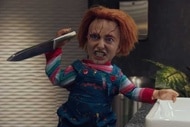Create a free profile to get unlimited access to exclusive videos, sweepstakes, and more!
Wallace & Gromit: The Curse of the Were-Rabbit is still a perfect homage to classic monster movies

Different horror subgenres go in and out of popularity. Scream brought back slasher movies in the ‘90s, and now we’re in the midst of a spooky wave of paranormal horror stories. Zombie movies keep coming back from the dead; and people keep finding ways to make found-footage horrors fresh. But, one classic genre of horror has never really enjoyed a modern resurgence — and it’s literally a “classic” genre.
Universal Classic Monsters, the old black and white Frankenstein, Wolf Man, Dracula, and all their creepy friends are horror icons, but the tropes and aesthetics of their type of film haven’t really flourished in recent years. Modern iterations tend to blend familiar monsters with a new genre to mixed effect; the 1999 Mummy was also a pulp adventure, the recent Invisible Man a thriller, and the 2017 Mummy a wanna-be shared universe superhero knockoff. None of those have the true spirit or stylistic hallmarks of monsters movies from the ‘40s. Perhaps audiences are too jaded, and what was once scary has become corny — childish, even, which is maybe why Wallace & Gromit: The Curse of the Were-Rabbit is the true torchbearer (and pitchfork-bearer!) of the most classic horror genre, angry villagers and everything.
Curse of the Were-Rabbit, which celebrates its 15th anniversary today, Oct. 5, is the big picture debut of Ardman Animation’s beloved claymation duo, Wallace and Gromit. The cheerful, delightfully British inventor and his silent canine companion went on some charming adventures over the course of three short films in the late ‘80s and early ‘90s: A Grand Day Out is a sci-fi space adventure with shades of 1902’s A Trip to the Moon; The Wrong Trousers is a classic heist; and A Close Shave is a criminal conspiracy-mystery. Although Wallace and Gromit are beloved British icons themselves, the pair have always had a penchant for genre. Curse of the Were-Rabbit blends the pair’s tea-and-cheese antics with all the stylings of Classic Monsters, especially 1941’s The Wolf Man and a decent dollop of both 1931’s Frankenstein and 1941’s Jekyll and Mr. Hyde.
The film finds the titular duo operating a humane pest-control business in the lead-up to the giant-vegetable competition in Tottington Hall, a perfect little version of an old British town (the sort that old-timey monsters used to frequent). Wallace’s attempts to brainwash rabbits so they’re no longer interested in plundering from the townsfolks’ gardens backfires when he accidentally has a mind-meld of sorts with one rabbit. The experience transforms the normally affable chap into a monstrous, Hulk-like bunny under the light of the full moon. Although hungry for carrots, Wallace’s Were-Rabbit alter-ego is ultimately more of a nuisance than a real danger, but it’s up to Wallace (so, mostly up to Gromit, really) to prevent Lord Victor Quartermaine, who already has a grudge against Wallace, from hunting down the Were-Rabbit with “gold-carrot” bullets. (The action culminates in a nod to King Kong, which, while not of the exact same ilk as the Classic Monsters, still feels fun and fitting.)
For fans of Universal Classic Monsters, it’s hard not to love all of Curse of the Were-Rabbit’s little winks and nods to the monsters of yore. It helps that Wallace & Gromit is a period piece of sorts. The shorts and the film are vaguely set in the ‘50s in a rural English town, which makes them pretty close to the settings of many of the old monster movies. With some exceptions, like Egypt and a certain Black Lagoon, most of the Universal movies are set in a small European town with fairly familiar, archetypal characters and a population that’s quick to become superstitious and almost as quick to rouse into an angry mob. Whatever aspects of the old monster movies that would feel dated now instead feel timeless due to the setting and the fact that it’s animated, which always helps soften blows to realism
Chances are that the primary audience for Curse of the Were-Rabbit, mid-’00s children, weren’t super familiar with horror movies that came out five or six decades before they were born. That’s OK — great, even — because the film still manages to capture the classic, somewhat quaint horror spirit of the old movies. Curse of the Were-Rabbit isn’t a scary movie by any means, but there are enough suspenseful bits and some cool sequences in darks woods that will make younger viewers feel a sense of connection with a whole style of movies from generations before them.
Beyond the loving homages to The Wolf Man and the rest of the “Monster Mash” usual suspects, Curse of the Were-Rabbit is also just a masterclass in all-ages entertainment and the power of animation. Ardman Animation, known for films like Chicken Run and Shaun the Sheep in addition to Wallace & Gromit, are masters of their stop-motion craft. Every scene, every movement, and every expression is deliberate. Gromit, by virtue of not speaking, is an endless source of subtle, expertly timed physical comedy. Everything in Curse of the Were-Rabbit feels so tactile and measured in a way that live-action films can’t achieve and most computer-animated films are either too polished or too hurried to pull off.
Due to the fickle nature of streaming availability, Curse of the Were-Rabbit is not streaming on any of the usual suspects on this, its 15th anniversary. The bulk of the Universal Classic Monster movies are streaming on Peacock. But, should you get the chance, or if you want to expose a kid to an old, largely ignored genre of horror without it being too scary or too dated, Wallace & Gromit have you covered.
SYFY WIRE and Peacock are properties of NBCUniversal, a subsidiary of Comcast Corporation.
























